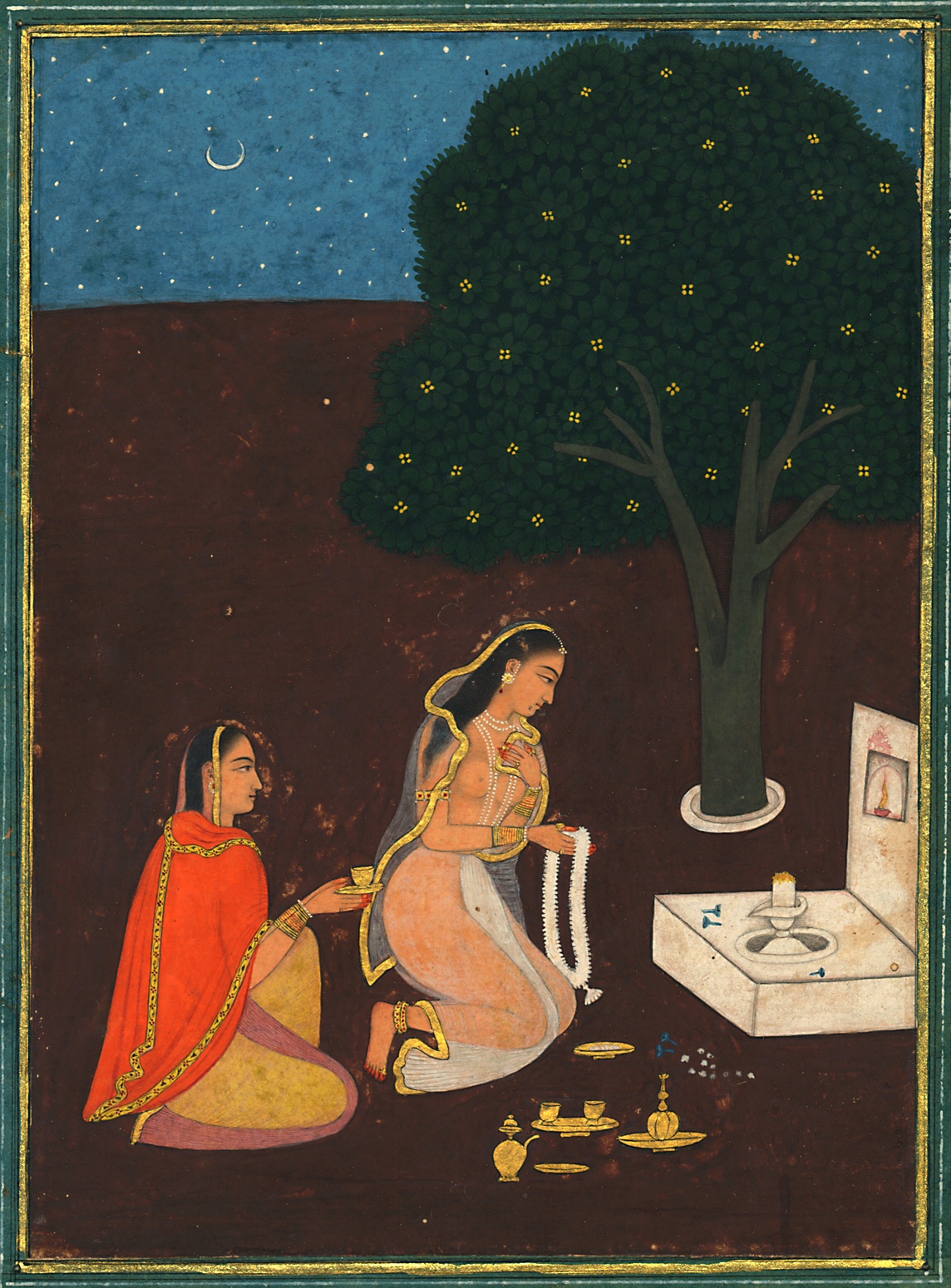Activity
Hinduism and the Practice of Faith
Religion pervades many aspects of Hindu life, and religious observance is not limited to one location, time of day, or use of a particular text. It assumes many forms: in the home, at the temple, on a pilgrimage, through yogic practices, dance or music, at the roadside, by the river, through the observation of one’s social duties and so on.

Woman worshiping at an outdoor shrine, personifying a musical mode (Bhairavi Ragini)
The image of women at worship is a common one in Indian paintings. In the example above, a female attendant observes as another woman kneels before a small outdoor shrine containing a linga— the phallic emblem representing the Hindu god Shiva. Scattered near the kneeling woman are ritual utensils, including water sprinklers and a bowl of flower offerings. The nudity of the woman, visible through her sheer dress, suggests that this private moment of worship is occurring immediately after her bath.
Puja
The general term used to describe Hindu worship is puja—the most common forms of worship taking place in the home at the family shrine and at the local temple. Practices vary depending on location, but generally speaking, the worshiper might approach the temple to give thanks, to ask for assistance, to give penance, or to contemplate the divine. Worship is tied to the individual or family group, rather than a service or congregational gathering. Puja occurs on a daily basis, or even several times throughout the day, as well as at specific times and days at local temples, and with abundant festivities on the occasions of great festivals.
In the temple, the devotees are assisted by the priest, who intercedes on their behalf by performing ritual acts, and blessing offerings. Worship often begins by circumambulating the temple. Inside the temple, the priest’s actions are accompanied by the ringing of bells, passing of a flame, and chanting. Traditionally, dance also formed an essential part of temple worship.
Darshan
A key concept in the worship of Hindu deities is the act of making eye contact with the deity (darshan). The activity of making direct visual contact with the god or goddess is a two-sided event; the worshiper sees the divinity, and the divinity likewise sees the devotee. This ritualistic viewing occurs between devotee and God in intimate domestic spaces, as well as in tremendously crowded temple complexes where the individual may be part of a throng of hundreds or thousands of other worshipers. It is believed that by having darshan of the god’s image, one takes the energy that is given by the deity, and receives blessings.
This essential Hindu practice also demonstrates the profound importance of religious imagery to worship and ritual. While in most other religious traditions images are believed to represent or suggest divine or holy personages, or are altogether forbidden, in Hindu practice painted and sculpted images are believed to genuinely embody the divine. Appropriate ritual imbues images with authentic divine presence. Literal physical connection in the form of visual contact is essential to religious devotion, whether on a local and ongoing basis, or in the undertaking of great pilgrimages.
Festivals and Pilgrimages
Festivals abound throughout India, and are usually accompanied by the creation of temporary images or the procession of temple icons through the streets with much celebration. Festivals take place at a number of sites across India and are associated with various deities. There are a number of sacred cities in India, and natural sites that are considered sacred such as the Ganges river. The calendar of Hindu festivals and holidays is generally established according to the lunar calendar. Festivals vary regionally, and particular festivals are most important and spectacular depending on the regional importance of the particular god or goddess.
For example, the goddess Kali is extremely popular in Calcutta, where her festival is renowned. In Mumbai (Bombay), the annual Ganesha festival is well-known for its size and fantastic clay images that are tossed into the sea.





